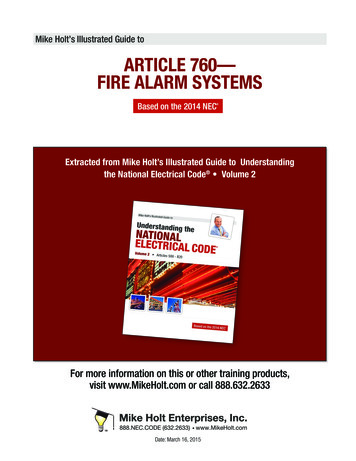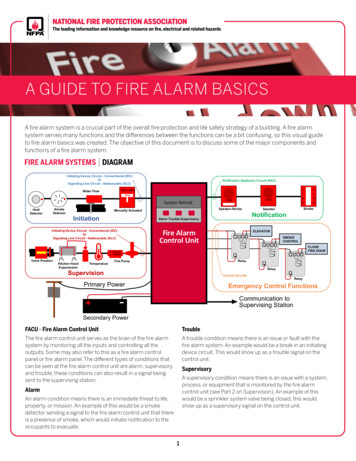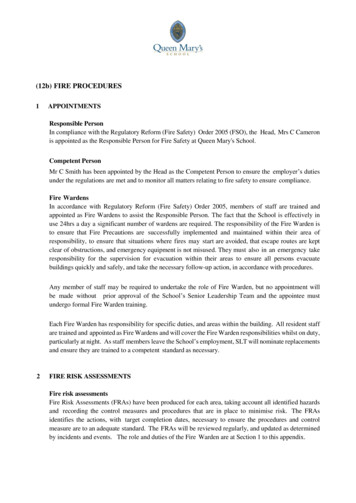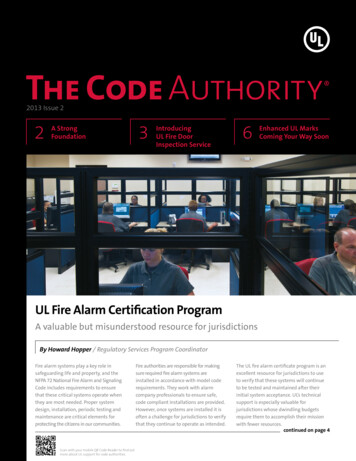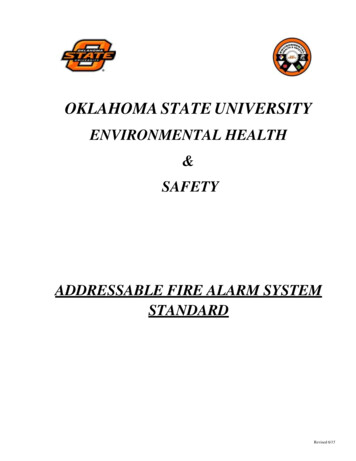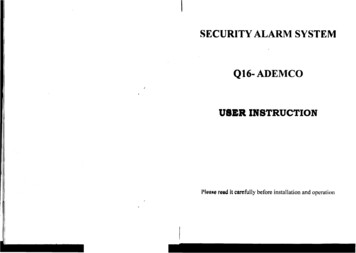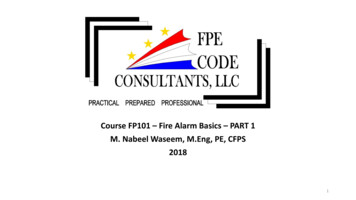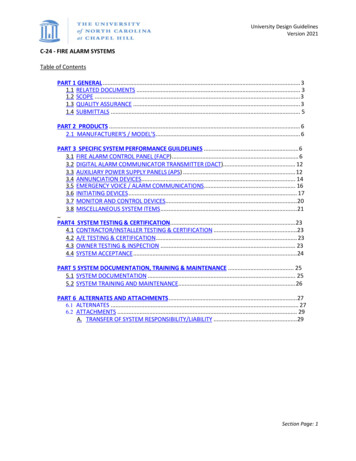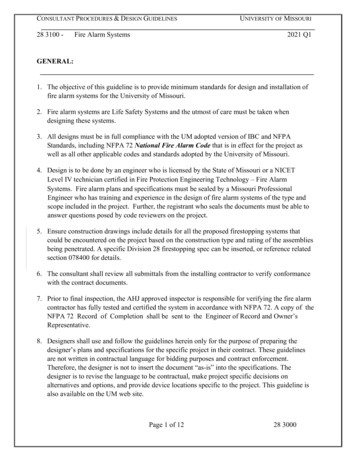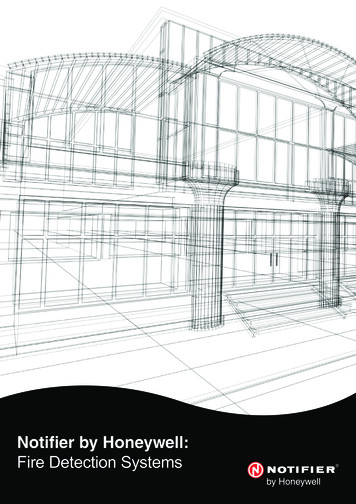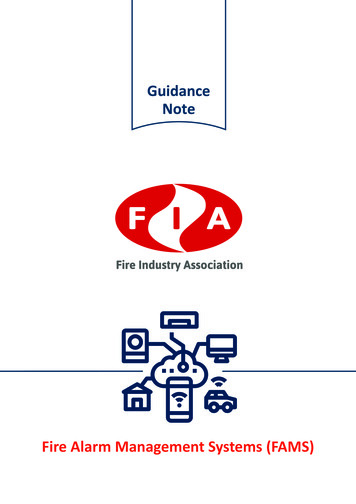
Transcription
GuidanceNoteFire Alarm Management Systems (FAMS)
FIA Guidance document – Fire Alarm Management Systems (FAMS)1. SCOPE. 32. INTRODUCTION. 33. OVERVIEW . 34. SUMMARY . 105. FURTHER RELEVANT PUBLICATIONS AND ONGOING WORK. 106. FURTHER RESEARCH. 117. BIBLIOGRAPHY. 11Created by supalerk laipawatfrom the Noun ProjectFire Alarm Management Systems (FAMS) Version 1 July 2021 Tel: 44 (0)20 3166 5002 www.fia.uk.com2 of 12
1. SCOPEThese FIA guidance notes give an introduction to what a Fire Alarm Management System(FAMS) is, and varying capabilities, uses and benefits.This guidance also discusses the interaction with FAMS and existing codes of practice andstandards with particular emphasis on GDPR, the provision of adequate Cyber security and acorrect management infrastructure.These guidance notes are to be used in conjunction with the information contained in othercodes of practices standards and guidance documents referred to directly within this file ordetailed in the bibliography section.2. INTRODUCTIONWhat are Fire Alarm Management Systems (FAMS)?Fire Alarm Management Systems (FAMS) is a generic term used for a system providingcontrol, monitoring and management of a sites fire alarm system.FAMS solutions have varying capabilities, most can communicate fire and fault activitywhich is sent to a cloud hosted database. Users can then access their sites fire alarm panelinformation through the internet or be alerted to activations on site via their mobile phone,using apps or SMS (short message service).The use of FAMS can be an advantage to servicing organizations and customers, whereremote checks can be undertaken prior to an engineer visiting site. As an example, anengineer can ensure they have the correct parts in their van before attending a site, “firsttime fixes”. This also has the added benefit of reducing a company’s carbon footprint, wherethe time spend on the road by engineers will be significantly reduced, as well as making thebusiness more efficient and leaner. If the size of the site requires two engineers to service asystem, with FAMS it may now only need one. Assistance with compliance for parts of thefire safety orders, are also be a major benefit to organisations.3. OVERVIEWFAMS Compliance and LimitationsFAMS are not currently required to be compliant to any particular standard, but variousmanufacturers are considering making application for formal product performance criteria.One such standard is BS EN 54-21, which is the Alarm transmission and fault warning routingequipment standard.Fire Alarm Management Systems (FAMS) Version 1 July 2021 Tel: 44 (0)20 3166 5002 www.fia.uk.com3 of 12
IMPORTANT NOTEIf the early summoning of the fire and rescue service is considered critical to the safetyof occupants, say based on a fire risk assessment, sites should be provided for automatictransmission of alarm signals to an Alarm Receiving Centre (ARC), unless there are reliablearrangements for summoning the fire and rescue service by persons in the building. Thiswill mean providing a primary signalling signal compliant with BS EN 54-21.An example where this is required is in residential care premises, facilities should beprovided for automatic transmission of alarm signals to an ARC. Also, for Category P(Property) category systems unless they are continuously occupied, they should alsoincorporate a means for automatic transmission of fire signals to an ARC.A FAMS without BS EN 54-21 compliance is providing complimentary signalling only or asecondary confirmation type signal, rather than primary signalling.Primary signalling would only be achieved by an Alarm Receiving Centre through productscompliant with BS EN 54-21.There is also a standard BS EN 54-13 which is for the assessment of compatibility andconnectability of fire detection and fire alarm system components. It specifies therequirements of the integrity of the fire detection and alarm system when connected toother systems. Should FAMS hardware be a type 2 component, so tested to ensure it has noadverse effect on a Type 1 component or potentially it could be used as a Type 1 component,if approved as an ancillary management product?Figure 1. Fire detection and fire alarm systems and associated systems,functions and equipmentFire Alarm Management Systems (FAMS) Version 1 July 2021 Tel: 44 (0)20 3166 5002 www.fia.uk.com4 of 12
FAMS Benefits and CapabilitiesDepending on the individual product concerned FAMS have the ability to be able tocommunicate full point identification for the whole of the sites Addressable Fire Detection &Alarm System, for a single panel to the complete fire alarm network. FAMS can also be usedfor Conventional Fire Alarm systems, where they are able to communicate Fire and Faultactivity for a site, but there will be limitations of systems functionality.Some of these FAMS products are also capable of remotely disabling fire alarm equipment,but these are mostly limited to FAMS offerings dedicated to a specific manufacturer, butpotentially through technology enhancements and protocol sharing, further capabilities forthese could be developed.FAMS can generate reports, notify, and record Manual Call Point weekly tests, to assist clientsfor compliance with Articles 13 & 17 in the Regulatory Reform (Fire Safety) Order RRFSO.The Fire (Scotland) Act and the Fire & Rescue Services (Northern Ireland) Order have similarreferences.FAMS can be used to provide independent evidence of maintenance testing, informationcommunicated to FAMS can be stored in an infinite log.The risk to life and property from fire is often dependant on the quality of fire safetymanagement, and how records are kept and maintained is one of the biggest failings inpremises. Digital records and remote service offerings can give that compliance with this partof a buildings Fire safety.FAMS could potentially be used as part of a sites fire evacuation plan, where on receipt ofnotification of fire on a site an action is carried out, which might be to say isolate a gas valvemanually on a site, or ensure other site fire safety management controls are undertaken.Cyber security and correct managerial controls with a FAMS discussed later in these noteswould be critically important.FAMS Signalling, Power Supplies & CommissioningFAMS have the capability of communicating either via the Ethernet wired or wirelessly viaGeneral Packet Radio Services (GPRS).Ethernet is a wired connection and is generally much faster (depending on the speed of theinternet connection), cable connections are also more secure. Sometimes in premises therewill be no Ethernet port availability in the vicinity of the cie and FAMS hardware.For ease of installation and convenience GPRS signalling may be employed as an alternative.GPRS is a packet switching technology that enable the transfer of data through cellularnetworks. Speeds can be an issue and the recording of signal strength and a thorough surveywill be required for each site.FAMS will require an adequate electrical supply to work. The question of if this should besourced from the FD&A CIE is one for the designer of the system to make. If adding FAMS toan existing system then it will probably require an external dedicated power supply to powerthe FAMS. This in turn would need to report any power supply faults to the FD&A CIE.Fire Alarm Management Systems (FAMS) Version 1 July 2021 Tel: 44 (0)20 3166 5002 www.fia.uk.com5 of 12
During the commissioning it will be necessary to verify that the FAMS product is actuallyworking. This will require testing the fire and fault signalling of a FAMS. The FAMS checkswill be built into a company’s commissioning methodologies and will vary widely dependingon the capabilities of the individual products. The recording of internet speeds, site GPRSsignal strengths. The information from these checks could be added to the commissioningcertificate in BS 5839-1:2017 or another dedicated form.FAMS – Initial Data Proformas & TrainingFAMS will require some client information for example, email addresses and telephonenumbers. These will need to be stored in the system, to enable automatic notifications andalerts, and also to control and limit permissions for managers and users.GDPR is an important consideration when putting this personal data together and isconsidered in greater detail on page 7 of these guidance notes.A proforma may need to be created and populated for the various options at the point ofcommissioning, so that the data can be correctly set up and it is recommended that this isagreed in writing.Below may be considered as example data that is required to be inputted into a FAMS: Username, title (role or position) Email addresses Phone numbers and permission levels (Could be several defined access levels depending onthe individual FAMS offering) What specific notifications are required and via what TIONAL IFYOU REQUIRENOTIFICATIONVIA SMS AND NOTJUST EMAIL)Example – Julie MannHeadPERMISSIONMANAGER ORUSERjm99999999@bt.com07777 999999ManagerExample – Will O’Connor Deputy Headwoc88888888@bt.com07777 888888ManagerExample – Neil JonesSite Facilitiesnj77777777@bt.com07777 777777ManagerExample – AlisonQuigleySite Engineeraq66666666@bt.com07777 666666UserExample – HannahBoatswainTeacherhb55555555@bt.com07777 555555UserExample – 777 444444UserExample – BenjaminLeachPE Headbl44444444@bt.com07777 333333ManagerFigure 2. Example Proforma InformationFire Alarm Management Systems (FAMS) Version 1 July 2021 Tel: 44 (0)20 3166 5002 www.fia.uk.com6 of 12
Figure 3. Notifications Email SMS or via an AppInformation can be populated by clients after suitable training but may also be directlyadministered by the FAMS product provider or another third-party company selling theproduct. Will the system have shared control between the product supplier and end user?Individual training requirements will depend on the capabilities and complexity of each FAMSand the individuals employed role as a manager or user.If adequate training is not undertaken this could lead to problems. As an example, what ifa user inadvertently removes a person through lack of understanding of the technology orthrough simple human error. This person will no longer receive an alert and for a Life safetysystem this could be a serious issue.How do FAMS operate, is data recoverable?A lot of the systems seen have dates and times from actions undertaken, be they alerts fromsites or times when a system was last logged into. FAMS products reviewed so far do havereset capabilities if issues are identified or raised. What will be the product support if there isan issue to escalate for further support are questions to be considered?Another consideration is the frequency at larger sites for members to be deleted or added.Would work email addresses and phone numbers only be the norm for adding into aparticular FAMS managers/administrators/engineers, so that if they do leave the business forany reason the access capability is removed through an internal IT process?Fire Alarm Management Systems (FAMS) Version 1 July 2021 Tel: 44 (0)20 3166 5002 www.fia.uk.com7 of 12
FAMS Data Protection GDPRAn understanding of the implications of compliance with General Data ProtectionRegulations (GDPR) is required for FAMS. GDPR’s primary aim is to give individuals controlover their personal data. GDPR is important as it improves the protection of data subjects’rights and clarifies what companies must do who process this data in safeguardingthose rights.All FAMS will need to comply with all applicable data protection and privacy legislationin force at the time in the UK, including the General Data Protection Regulation ((EU)2016/679), the Data Protection Act 2018, and the UK General Data Protection Regulation.Controllers and processors of personal data must have in place appropriate technicaland organizational measures to implement all of the required the GDPR principles. GDPRdoes not mandate a specific set of cyber security measures but expects you to takeappropriate actions.FAMS Cyber SecurityCyber security or information technology security is the protection of our computer systemsfrom information disclosure, theft, or damage to the hardware, software, or electronic dataas well as disruption or misdirection of the services being provided.As we become more reliant on the Internet of Things (IoT) and Software as a Service(SaaS) cyber security needs to be carefully considered, for Life safety fire alarm systems,the consequences for an attack on design vulnerabilities in a fire alarm system would beintolerable, GDPR aside. The Control & Indicating Equipment) (CIE) could potentially betampered with, passwords changed, controls and functionality could be lost. Depending onthe specific capabilities of a FAMS, areas of detection and or sounders could be disabled.There may be phishing attempts to acquire sensitive customer or our managers/administrators /engineer’s information such as usernames, addresses phone numbers.Malware could be installed, and data permanently deleted.Large corporations can be targeted for financial gain or attacks can simply be malicious,depending on the nature of the customers involved attacks may be politically motivated.In the UK, the National Cyber Security Council was set up to help protect critical servicesfrom cyber-attacks and to improve the underlying security of the UK internet. Its aim is tomake the UK a safe place to live and be able to conduct business online.Most countries have their own versions, as another example in America there is the NationalInstitute of Standards & Technology (NIST) which provides frameworks for improving criticalinfrastructure cyber security.Considerations may also need to be made to each product manufacturers individualrequirements for data security and this could mean adhering to specific managementstandards and processes that have been produced and accepted as good practice.Fire Alarm Management Systems (FAMS) Version 1 July 2021 Tel: 44 (0)20 3166 5002 www.fia.uk.com8 of 12
It is appreciated that Cyber security technologies and standards are complex. One way aproduct manufacturer can demonstrate how secure its product is, is by having what is knownas a Penetration test or “Pen test” completed of its system. Penetration Testing, otherwiseknown as Pen testing, is where attempts are made to compromise or gain unauthorizedaccess to a particular network or application. The process is sometimes referred to as“white hat hacking” or “Ethical hacking”. This is where a qualified professional will attempt touncover vulnerabilities and misconfigurations that present themselves as a cybersecurity risk.This will give product manufacturers an overview of their security, highlighting flaws so theycan be sorted before they are picked up by malicious hackers. Penetration tests evidence willbe mandatory for some companies and compliance schemes.It may be a possibility that a product manufacturer may not want to share results of aPen test highlighting its flaws and vulnerabilities. A Non-Disclosure Agreement (NDA) orconfidentiality agreement contract may need to be agreed between parties to protect thisinformation.Now in addition to Pen tests control processes are extremely important. Businesses may aska company to provide proof of compliance. There are two similar frameworks for this, ISO27001 certification or a SOC 2 report.BS EN ISO/IEC 27001:2017 is a generic standard applicable to all organizations, regardlessof type size or nature which specifies Information Security Management System (ISMS)requirements for establishing, implementing, maintaining, and continually improving aninformation management systems.A security management system preserves confidentiality, integrity, and availability bycreating a risk management process so clients/customer’s, insurers and third parties can seethey are being looked after against the threat of cyber-attacks.It is expected that an organization considers this and has a process in place, scaled to the sizeand needs of the organization.Now if a product manufacturer is not specifically accredited to ISO 27001 another route todemonstrating compliance is by providing a SOC 2 Type 2 report.A SOC 2 TYPE 2 report is created by an external auditor who will assess the effectiveness ofan organizations controls regarding security, availability, processing integrity, confidentialityand or privacy. It captures how a company will safeguard a customer’s data, and how wellthose controls are working.ISO 27001 accreditation and a SOC 2 Type 2* report is fundamentally the same. The onlydifference is who conducts the audit. A recognized accreditation body completes ISO 27001certification whereas SOC 2 reports are completed by a licensed company or individual.*NOTE: Sometimes 2 written as “II” instead of 2.If you are a service provider, or a service organization, which stores, processes, or transmitsany kind of information, you may be required to have either ISO 27001 or a SOC 2 Type 2 toremain in a competitive market. Some companies are demanding such accreditation.Fire Alarm Management Systems (FAMS) Version 1 July 2021 Tel: 44 (0)20 3166 5002 www.fia.uk.com9 of 12
IMPORTANT NOTEWhen hosting customer data as part of your overall product architecture, it is importantto use a reputable and cyber security certified cloud hosting provider. But that is onlythe beginning of your cloud security responsibilities. When leveraging Infrastructureas a Service (IaaS), you hold the responsibility for the servers and cloud configurationmanagement within your tenant space.The providers of these services work as shared responsibility models between themselvesand the customer. Shared models help to relieve operational burdens, but limitations areto the infrastructure, hardware, software, and networking specific to the cloud service.Customers responsibilities is defined by the services they require but there will always besome level of shared responsibility in the guest space.So vulnerability scanning and patching, central logging and monitoring, antivirus, andcloud configuration hardening, as well as ensuring your code is vulnerability free andall third-party components are properly licensed, are critical steps to provide end to endsecurity of your product. In a nutshell, an individual product manufacturer also needs tobe operating under an ISO 27001 accreditation scheme or have a SOC 2 Type 2 report todemonstrate its compliance.4. S UMMARYWith the turning off of the Public Switched Telephone Network (PSTN) in 2025 and theswitch to a data focused network rather than a voice network. FAMS will have a hugepotential in helping to improve fire safety, assisting duty holders of premises, reducing ourcarbon footprint and will improve the quality of service to clients.As we become more reliant on these innovative product offerings and through technologicaldevelopments, it may be possible that existing codes of practice are changed or amended toaccept these as viable alternatives or the accepted solution.Where FAMS are used, the controls and processes need to be stringent for the Life safety andor Property protection. Cyber security cannot be an afterthought and must be addressed forconfidence in the integrity of a product.5. FURTHER RELEVANT PUBLICATIONS AND ONGOING WORKEN 50710 Remote services Standard – This is currently in a draft format. When this standardis released more guidance will be available and we will know definitively industry expectedstandard requirements. The introduction of EN 16763 and the services directive alreadyrequires a pan European approach for remote access, so all tasks will need to be completedby qualified person as one example. The EN 50710 document specifies the minimumrequirements for the provision of secure remote services via a remote access infrastructure(RAI) carried out either at site or off-site (e.g. via IP connections) to fire safety systemsincluding, but not limited to, fire detection and fire alarm systems, fixed firefighting systems,smoke and heat control systems. Aware that remote access infrastructure is in EN 50136series and there is being the IOT cyber security considerations.Fire Alarm Management Systems (FAMS) Version 1 July 2021 Tel: 44 (0)20 3166 5002 www.fia.uk.com10 of 12
6. FURTHER RESEARCHCEN TECHNICAL COMMITTEE NO 79: ALARM SYSTEMS7. BIBLIOGRAPHYBS ISO/IEC 27001:2013 Information technology – Security techniques – Information securitymanagement systems.BS 5839-1:2017 – Code of practice for design, installation, commissioning, and maintenanceof systems in non-domestic premises.CREST – Council for Registered Ethical Security Testers- International not for profitaccreditation & certification body.Data Protection Act 2018 and UK General Data Protection Regulation (GDPR).EN 54 – 13 Non-harmonized Assessment of compatibility & connectivity of fire detectionsystems.EN 54-21 Harmonised Alarm transmission & fault warning routing equipment.EN 50710 Requirements for the provision of secure remote services for fire safety systemsand security systems.EN 16763 Services for fire safety systems and security systems.EN 50136-1:2012 A1:2018 – Alarm systems – Alarm transmission systems and equipment –Part 1: General requirements for alarm transmission systems.ETSI – European Telecommunications Standards Institute – Cyber Security for ConsumerInternet of Things.Fire (Scotland) Act 2005.Fire & Rescue Services (Northern Ireland) Order 2006 & The Fire Safety Regulation(Northern Ireland) 2010.ISO/IEC 27000 (series), Information technology – Security techniques – Information securitymanagement systems – Overview and vocabulary.NCSC – National Cyber Security Centre – MCSS Minimum Cyber Security Standards.NISTIR 8259 – Foundational Cybersecurity Activities for IoT Device Manufacturers.PAS 555 – Cyber Security Risk – Governance & Management.PAS 79-1 Fire risk assessment – Part 1: Premises other than housing – Code of practice.Regulatory Reform (Fire Safety) Order RRFSO 2005.SOC 2 TYPE 2 – Systems & Organizational controls. Type 2 assess controls.UL 2900 – Series of Standards for Cybersecurity assurance program.Fire Alarm Management Systems (FAMS) Version 1 July 2021 Tel: 44 (0)20 3166 5002 www.fia.uk.com11 of 12
Fire Alarm Management Systems (FAMS) sersion 1 July 2021 Tel: 44 (0)20 3166 5002 www.fia.uk.com 3 of 12 1. SCOPE These FIA guidance notes give an introduction to what a Fire Alarm Management System (FAMS) is, and varying capabilities, uses and benefits.
